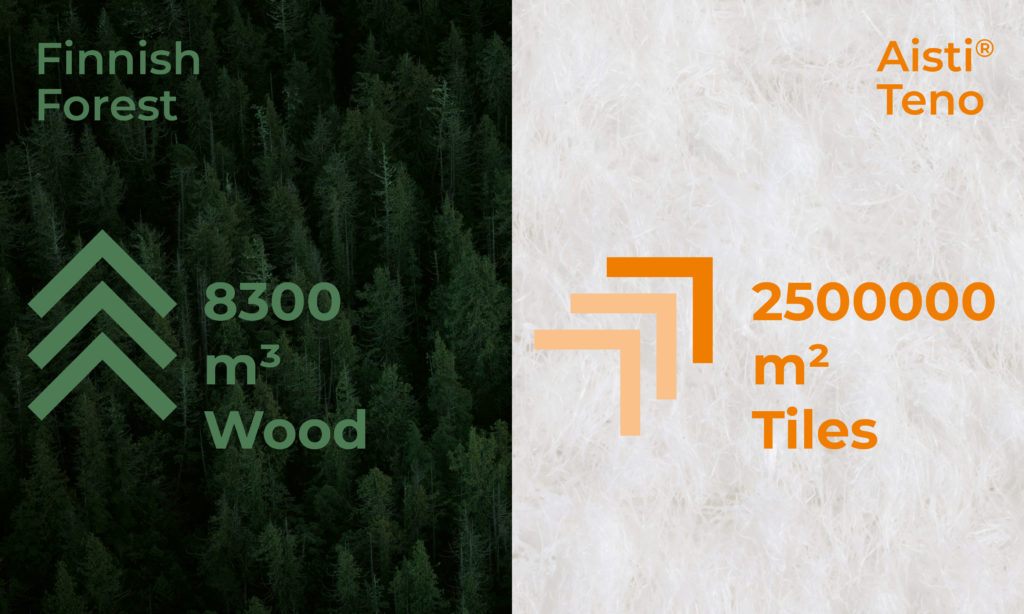
Tracing wood fiber: Aisti’s Founder & COO asks what about the trees?
By Antti Fredrikson, Founder & Chief Operating Officer
Reading time: 5 min.
As concerns about climate change continue to mount, leaders in the construction industry are racing to find innovative solutions to decrease their projects’ carbon emissions. At Aisti saw the industry’s desperate need for new solutions to buildings’ non-operation-related greenhouse gas emissions, most prominently the need for recyclable and sustainable construction materials.
We looked to nature for inspiration and developed wood fiber-based acoustic products that could offer a sustainable solution to traditional fossil, hard-to-recycle, non-renewable, and plastic-heavy materials fueling the climate crisis. While nature offered us a pure and renewable solution to accelerate the decarbonization of the industry, we had to ask ourselves one important question – what about the trees?
As COO of Aisti, my commitment to the industry is fueled by a deep concern for the future of our forests. Preserving and sustaining these vital resources is a top priority for Aisti, driving us to explore innovative solutions and implement responsible operational processes.
Natural Sequestration of CO₂ with Aisti® Teno
Our fiber-based acoustic tiles present a promising solution for the construction industry to store CO₂ from the atmosphere and reduce the impact of the climate crisis. Aisti® Teno tiles are affordable and functional acoustic solutions that are safe for those who install them and end-users who live and work around them.
The wood fiber used as the main ingredient in our tile acts as a carbon sink. So, one m² of Aisti® Teno tiles bind 1.98 kg of CO₂ per m2, ultimately reducing the amount of CO₂ in the atmosphere. By 2030, thanks to wood fiber, our tiles from the first factory can reduce the industry’s CO₂ emissions by up to 125 kilotons—a massive win for the construction industry in its climate actions.
But what about the trees?
On the one hand, we have this novel solution to reduce the building industry’s CO₂ emissions (Responsible for 39% of global energy-related carbon emissions). On the other hand, we must consider how the overuse of wood materials could lead to the strain of natural resources, loss of natural habitats and deforestation.
As manufacturers of fiber-based acoustics that rely on wood pulp, we are passionate about the upside of using this natural material. However, we also carefully evaluate the potential impact of scaling up our production on biodiversity.
From Trees to Tiles: An Exceptional Acoustic Journey
Firstly, we wanted to measure and report on our wood consumption accurately. The beauty of ethically harvesting trees is that we can track back the origin of the trees. We use certified suppliers that use mature wood fiber trees, which have completed their entire CO2 sequestration and are ready for harvest.
To measure our annual wood consumption, we calculated the rate at which we needed to replant trees to maintain the health and well-being of the forest ecosystem. This begins by transparently calculating the rate at which we consume from the forest.
Let’s do the math together:
According to the Ministry of Agriculture and Forestry in Finland, Finland’s increment of forests was 103 million cubic meters in 2021. In Finland, tree growth season lasts from mid-May to mid-August, nearly 100 days.

How much forest volume are we harnessing to gain the wood fiber we need?

By the end of 2025, Aisti’s first commercial factory will use about 3000 tn of wood pulp per year, which is mechanically pulped from 8300m3 of European spruce logs. The yield of mechanical pulping is 90%, and the average density of spruce is 0.4 tn of fibers per m3 of wood.

How quickly can the forest grow our wood fiber supply?
It takes the Finnish forest 11.6 minutes to grow our annual production of 2.5Mm2 of Aisti Teno Acoustic Tiles. Follow Aisti® Teno’s journey from tree to tile in the illustration below.

Maximizing Raw Materials
Secondly, we invested in operational practices to maximize the efficiency of our raw materials:
- Sustainable sourcing: Obtain wood-fiber raw materials from responsibly managed forests and ensure they meet sustainable sourcing certifications such as FSC® or PEFC.
- Diversification: Diversify raw material sourcing by developing alternative products from other renewable resources to reduce dependency on virgin wood-fiber raw materials.
- Resource optimization: Minimize the use of raw materials in production processes and optimize the use of by-products to minimize waste.
- Recycling: Incorporate recycling processes to reuse wood-fiber materials whenever possible.
- Energy efficiency: Implement energy-efficient production processes and technologies to minimize the use of fossil fuels and reduce carbon emissions.
- Research and Development: Invest in R&D to develop new technologies and processes to increase the efficiency of wood-fiber raw materials usage.
- Collaboration: Collaborate with other companies and organizations to share best practices and develop new solutions for raw material efficiency.
Sustaining the environment is not limited to using bio-based raw materials, but also involves responsible sourcing, efficient use, and reuse of these materials.
At Aisti, we set out with a genuine concern and passion for taking tangible steps toward the sustainable sourcing and management of the wood fiber we use. With a transparent and traceable supply chain strategy, we can track our raw materials’ origin and implement effective measures to balance out what we consume.
Visit our impact page for more information about our sustainability commitment.
The article was updated on 11.09.2023


